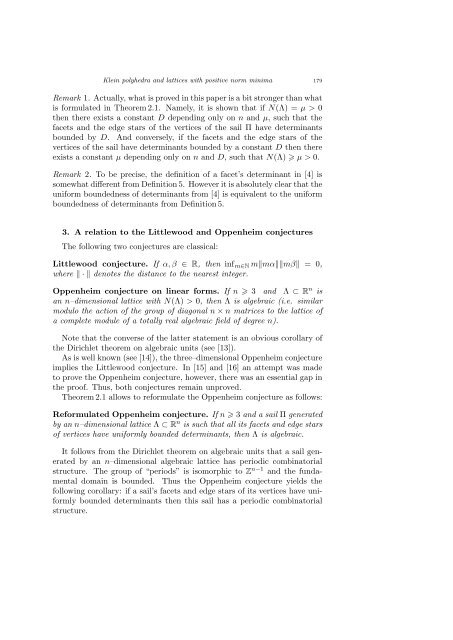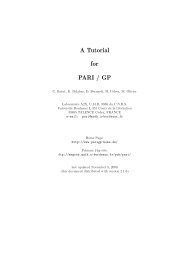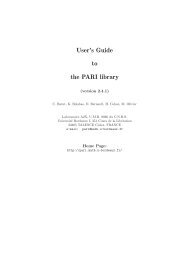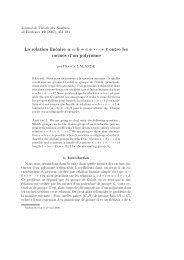multidimensional polyhedron
Klein polyhedra and lattices with positive norm minima
Klein polyhedra and lattices with positive norm minima
- No tags were found...
You also want an ePaper? Increase the reach of your titles
YUMPU automatically turns print PDFs into web optimized ePapers that Google loves.
Klein polyhedra and lattices with positive norm minima 179<br />
Remark 1. Actually, what is proved in this paper is a bit stronger than what<br />
is formulated in Theorem 2.1. Namely, it is shown that if N(Λ) = µ > 0<br />
then there exists a constant D depending only on n and µ, such that the<br />
facets and the edge stars of the vertices of the sail Π have determinants<br />
bounded by D. And conversely, if the facets and the edge stars of the<br />
vertices of the sail have determinants bounded by a constant D then there<br />
exists a constant µ depending only on n and D, such that N(Λ) µ > 0.<br />
Remark 2. To be precise, the definition of a facet’s determinant in [4] is<br />
somewhat different from Definition 5. However it is absolutely clear that the<br />
uniform boundedness of determinants from [4] is equivalent to the uniform<br />
boundedness of determinants from Definition 5.<br />
3. A relation to the Littlewood and Oppenheim conjectures<br />
The following two conjectures are classical:<br />
Littlewood conjecture. If α, β ∈ R, then inf m∈N m‖mα‖‖mβ‖ = 0,<br />
where ‖ · ‖ denotes the distance to the nearest integer.<br />
Oppenheim conjecture on linear forms. If n 3 and Λ ⊂ R n is<br />
an n–dimensional lattice with N(Λ) > 0, then Λ is algebraic (i.e. similar<br />
modulo the action of the group of diagonal n × n matrices to the lattice of<br />
a complete module of a totally real algebraic field of degree n).<br />
Note that the converse of the latter statement is an obvious corollary of<br />
the Dirichlet theorem on algebraic units (see [13]).<br />
As is well known (see [14]), the three–dimensional Oppenheim conjecture<br />
implies the Littlewood conjecture. In [15] and [16] an attempt was made<br />
to prove the Oppenheim conjecture, however, there was an essential gap in<br />
the proof. Thus, both conjectures remain unproved.<br />
Theorem 2.1 allows to reformulate the Oppenheim conjecture as follows:<br />
Reformulated Oppenheim conjecture. If n 3 and a sail Π generated<br />
by an n–dimensional lattice Λ ⊂ R n is such that all its facets and edge stars<br />
of vertices have uniformly bounded determinants, then Λ is algebraic.<br />
It follows from the Dirichlet theorem on algebraic units that a sail generated<br />
by an n–dimensional algebraic lattice has periodic combinatorial<br />
structure. The group of “periods” is isomorphic to Z n−1 and the fundamental<br />
domain is bounded. Thus the Oppenheim conjecture yields the<br />
following corollary: if a sail’s facets and edge stars of its vertices have uniformly<br />
bounded determinants then this sail has a periodic combinatorial<br />
structure.









